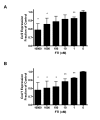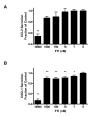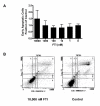Inhibition of oncogene-induced inflammatory chemokines using a farnesyltransferase inhibitor
- PMID: 18304343
- PMCID: PMC2268934
- DOI: 10.1186/1476-9255-5-3
Inhibition of oncogene-induced inflammatory chemokines using a farnesyltransferase inhibitor
Abstract
Background: Farnesyltransferase inhibitors (FTI) are small molecule agents originally formulated to inhibit the oncogenic functions of Ras. Although subsequent analysis of FTI activity revealed wider effects on other pathways, the drug has been demonstrated to reduce Ras signaling by direct measurements. The purpose of the current study was to determine if FTI could be used to inhibit the inflammatory activities of a known Ras-activating human oncoprotein, RET/PTC3. RET/PTC3 is a fusion oncoprotein expressed in the thyroid epithelium of patients afflicted with thyroid autoimmune disease and/or differentiated thyroid carcinoma. Previous studies have demonstrated that RET/PTC3 signals through Ras and can provoke nuclear translocation of NFkappaB and the downstream release of pro-inflammatory mediators from thyroid follicular cells in vitro and in vivo, making it an ideal target for studies using FTI.
Methods: For the studies described here, an in vitro assay was developed to measure FTI inhibition of RET/PTC3 pro-inflammatory effects. Rat thyrocytes transfected with RET/PTC3 or vector control cDNA were co-cultured with FTI and examined for inhibition of chemokine expression and secretion measured by RT-PCR and ELISA. Immunoblot analysis was used to confirm the level at which FTI acts on RET/PTC3-expressing cells, and Annexin V/PI staining of cells was used to assess cell death in RET/PTC3-expressing cells co-cultured with FTI.
Results: These analyses revealed significant mRNA and protein inhibition of chemokines Ccl2 and Cxcl1 with nanomolar doses of FTI. Neither RET/PTC3 protein expression nor apoptosis were affected at any dose of FTI investigated.
Conclusion: These data suggest that FTI may be applied as an effective inhibitor for RET/PTC3-oncogene induced pro-inflammatory mediators.
Figures





Similar articles
-
Interleukin 24 is induced by the RET/PTC3 oncoprotein and is an autocrine growth factor for epithelial cells.Oncogene. 2004 Sep 30;23(45):7571-9. doi: 10.1038/sj.onc.1207964. Oncogene. 2004. PMID: 15326486
-
High iodine concentration attenuates RET/PTC3 oncogene activation in thyroid follicular cells.Thyroid. 2009 Nov;19(11):1249-56. doi: 10.1089/thy.2008.0408. Thyroid. 2009. PMID: 19725779
-
Chronic expression of RET/PTC 3 enhances basal and insulin-stimulated PI3 kinase/AKT signaling and increases IRS-2 expression in FRTL-5 thyroid cells.Mol Carcinog. 2004 Oct;41(2):98-107. doi: 10.1002/mc.20042. Mol Carcinog. 2004. PMID: 15378648
-
[Genetic factors predisposing to the development of papillary thyroid cancer].Endokrynol Pol. 2005 May-Jun;56(3):339-45. Endokrynol Pol. 2005. PMID: 16350729 Review. Polish.
-
Molecular events in follicular thyroid tumors.Cancer Treat Res. 2004;122:85-105. doi: 10.1007/1-4020-8107-3_4. Cancer Treat Res. 2004. PMID: 16209039 Review.
Cited by
-
Inhibition of protein geranylgeranylation and farnesylation protects against graft-versus-host disease via effects on CD4 effector T cells.Haematologica. 2013 Jan;98(1):31-40. doi: 10.3324/haematol.2012.065789. Epub 2012 Jul 16. Haematologica. 2013. PMID: 22801964 Free PMC article.
References
-
- Akamizu T. [Genetic and environmental factors of autoimmune thyroid diseases] Nippon rinsho. 1999;57:1697–1702. - PubMed
-
- Vezys V, Lefrancois L. Cutting edge: inflammatory signals drive organ-specific autoimmunity to normally cross-tolerizing endogenous antigen. J Immunol. 2002;169:6677–6680. - PubMed
-
- Ciric J, Beleslin-Nedeljkovic B. [Differentiated thyroid carcinoma in previously manifested autoimmune thyroid disease] Srpski arhiv za celokupno lekarstvo. 2005;133 Suppl 1:74–76. - PubMed
LinkOut - more resources
Full Text Sources
Research Materials
Miscellaneous

